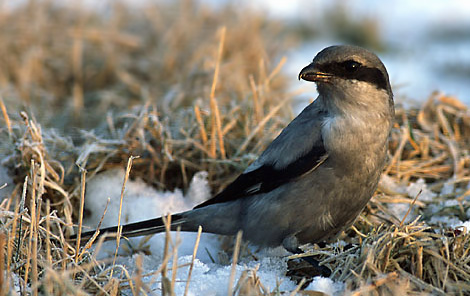| Kingdom: Animalia Phylum: Chordata Class: Aves (Birds) Order: Passeriformes Family: Laniidae |
|
Northern Shrike (Lanius excubitor), also called Great Grey Shrike, is a vagrant in India. Size: 25 cm. Shrikes of the family Laniidae are predatory songbirds with broad, hooked bills, dark masks and low, undulating flight. The name "shrike" is derived from the word "shriek" referring to their harsh calls. Known for impaling their prey on sharp objects, such as thorns or plant spines, shrikes are also called "butcher birds". Perching conspicuously atop high trees with their tails erect and bobbing, they scan the open country for prey. Their Latin name implies these behaviors as Lanius excubitor means "butcher sentinel". The species name (excubitor), however, is a misnomer because their erect, hunting perch was originally mistaken for a warning of danger to other birds! Descriptions: Solitary and uncommon, the robin-sized Northern Shrike is found in open, coniferous-deciduous forests, scrub thickets, taiga and woodland margins. These smallish predators are proportionally large-headed and resemble the Northern Wheatear from a distance. Adults display large, heavy, hooked bills with lighter lower mandibles and are pale-gray above with white rumps and bellies. While the tail and wings are dark, a diagnostic white patch highlights the wings. Their conspicuous, dark masks do not extend above the eye, as in other shrikes. Although adult birds have faintly streaked flanks, the brownish juveniles are heavily barred below. Vocalizations: As their name implies, the liquid song of the Northern Shrike is composed of low-pitched, shrill cries and rattles, "kdldi" or "plid-plid". Their call may be a nasal and complaining "fay, fay," a harsher "reed, reed, reed" or a dry "shraaaa". Nests: Northern Shrikes build bulky, cup-shaped nests in spruce trees and shrubs. Symmetrically constructed of matted grasses and twigs, the nests are often well concealed deep within the shrubs or spruce trees. Softly lined with mosses, feathers and hair, the nests house the 4-9, 27 mm eggs of the clutch. Eggs are grayish to greenish-white and heavily splotched with olive, brown and lavender. The clutch is incubated for 15-16 days and the brood fledges in another 20 days post-hatching. Food: As predators, Northern Shrikes primarily hunt insects but will take small birds and mammals (mice), as well as prey larger than themselves! Scanning from their high perches, these birds swoop down in aerial pursuit after flying prey. Since they lack talons, they stun or kill their prey with blows from their powerful beaks and then impale it on sharp objects. Recent research indicates that the impaled prey is used not only as a food cache but also to establish territories and attract mates. |
| |

